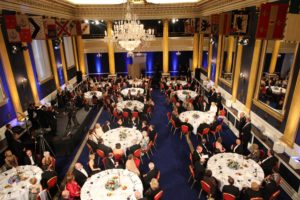18th May 2021 Dublin, Ireland
Past, present and future: a visit like no other
At noon on 9 April, I was in a Zoom call with some officials and historians, discussing the centenary to be marked in early May. It was thus in a discussion of 1921 that the news came that The Duke of Edinburgh, born himself that year, had passed away. Hardly had I ended that call than my phone rang. It was Mary McAleese, calling to pass on her condolences and to recall the warmth and significance of the Duke’s visit to Ireland with The Queen in 2011.
This week marks the tenth anniversary of that visit. In my few months here I have lost count of how many Irish friends and colleagues have talked to me about its impact. An Irish diplomat, in Dublin Castle on the night of the state banquet, told me the hairs on his neck had stood up as The Queen began her speech, in Irish, with the now famous words “A Uachtaráin agus a chairde”. Olivia O’Leary said that quickly became a jingle on a Dublin radio station.

Photo: Maxwells Dublin, Irish Government pool picture
This was not the first Royal visit to Ireland in recent years. But it was the first time a reigning British monarch had been to Ireland, since The Queen’s grandfather, George V, 100 years before. Before the First World War, before the 1916 uprising, before Ireland’s independence, before the Civil War, before so much – too much – blood had been spilled.
As The Queen recalled, “our islands have experienced more than their fair share of heartache, turbulence and loss… With the benefit of historical hindsight we can all see things which we would wish had been done differently or not at all.” And this was the spirit in which The Queen visited the Garden of Remembrance, the National War Memorial, and Croke Park.
But this visit was not all retrospect. The Queen was also looking at the recent past, and to a more hopeful future. In recalling a miracle of diplomacy then barely a dozen years old, The Queen described the achievement of peace in Northern Ireland as a “knot of history that was painstakingly loosened by the British and Irish Governments together with the strength, vision and determination of the political parties”. She echoed this in Her message to the people of Northern Ireland two weeks ago, in which she again recognised “the important contribution made by our friends and closest neighbours”.
The Queen and Prince Philip concluded their visit in Cork. In the entrance to the Embassy we have a photograph, which Mary McAleese said had entered the iconography of Ireland, of The Queen sharing a joke with a beaming fishmonger, Pat O’Connell. I had the pleasure of meeting Pat on my own recent (virtual) visit to Cork, and I look forward to following in Royal footsteps all the way to the English Market.
Looking back at the images of that visit, re-reading The Queen’s words and talking to those who took part, it’s clear that this was more than a visit, more than a ceremonial occasion or piece of statecraft. It was all of that, but it was much more. At the one time deeply personal, but also an occasion of state, deeply reflective, but also forward-looking, touched with sadness and respect, but also infused by hope and humour. For that, a lot of the credit goes to the government and people of this country, and organisations across Ireland, who contributed so much to the visit.
The Queen spoke at Dublin Castle about what she called “the complexity of our history, its many layers and traditions, but also the importance of forbearance and conciliation, of being able to bow to the past but not be bound by it.”. That delicate balance has been evident, I feel, in the way the 2 governments have approached the so-called decade of centenaries.
My Irish friend whose hairs stood up in Dublin castle once said to me that the great asymmetry in the relationship was that British people didn’t know enough Irish history while Irish people knew too much British history. On the whole, my career in diplomacy has taught me that you can’t know enough history if you want to make good judgements about the present, let alone the future. But I know what he meant.
Ten years ago this spring I was preparing to be posted as Her Majesty’s Ambassador to Sweden and met The Queen at Buckingham Palace, just before she left for Ireland. Little did I imagine that 10 years later I would have the honour of being Her Ambassador to Ireland.
Much has changed in the intervening decade and changes will continue to flow. But some things are unchanged. As The Queen put it, “ties of family, friendship and affection are our most precious resource. They are the lifeblood of the partnership across these islands, a golden thread that runs through all our joint successes so far, and all we will go on to achieve.”
It’s that bedrock of human contacts, across families, business, charities, sport, science and culture, which is integral to the history, but also the foundation of the future. As we look back to that remarkable visit, it’s the warmth of her words and your welcome that point us towards all we can seek to do together in the decade to come, and beyond.